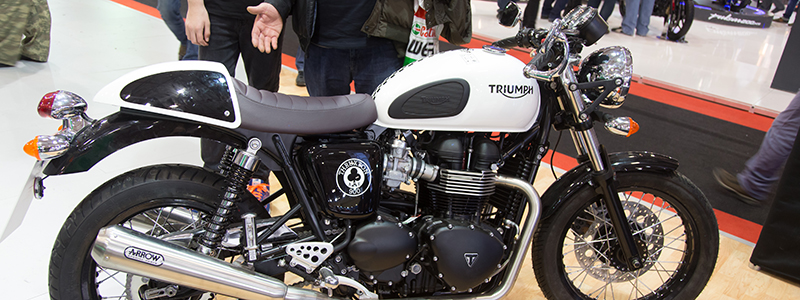
“The Centre should cut import duty on products which don’t conflict with the already existing Indian manufacturers”
There is no denying the fact that Indian two-wheeler industry, particularly the motorcycle segment, is the biggest in the world, in volume wise of course! Though the segment is largely dominated by pint-sized 100-150cc motorcycles but slowly and steadily higher (cubic) capacity luxury brands are also getting popular not only the metros but also in Tier-I and Tier-II cities. Moreover, as luxury motorcycle makers from around the world are also looking for markets beyond developed economies, where the growth has either slowed down or stagnant due to the economic conditions there. That’s the reason why India has seen a flood of various luxury motorcycle brands flowing into the country. The latest entrant in this segment is Triumph Motorcycles. Speaking exclusively to The Dollar Business, Triumph Motorcycles India Managing Director Vimal Sumbly talks about the iconic British brand’s existing and future offerings for the market. Interview by Sisir Pradhan | The Dollar Business  The Dollar Business (TDB): While many international brands struggle to find a foothold in India, your company sold around 1,300 units in the very first year of its operation in the country. How do you see the journey so far? Vimal Sumbly: The journey so far has been spectacular. We have sold 1,300 motorcycles in our very first year. The brand has 10 dealerships fully operational with latest corporate identity for Triumph and is looking at expanding its footprint in the country. This gives us great national presence and provides customers an ideal platform to experience the brand in India. Moreover, all dealerships provide one stop solution for sales, service and spares, which we call 3S Facility, and a huge array of accessories under one roof. We have also tied up with HDFC Bank and Castrol, which is an extension of providing better buying and ownership experience to customers and we also provide our customers with 24/7 road side assistance within 200km of every dealership. In a bid to increase brand awareness, we also have started Triumph rides in India in a big way. We have already organized more than 100 rides, and one of our most successful ride was on Independence day in 2014 which saw over 150 Triumph riders across eight cities pay tribute to the nation the Triumph way. More recently, we celebrated a successful one year at the India Bike Week (IBW) 2015 held at Goa with all our esteemed customers. The enthusiasm we saw at IBW from patrons as well as enthusiasts was extremely inspiring. All in all we feel that the brand has found a strong foothold within the luxury motorcycle category in India and we are successfully providing riders with an unparallel riding and ownership experience.
The Dollar Business (TDB): While many international brands struggle to find a foothold in India, your company sold around 1,300 units in the very first year of its operation in the country. How do you see the journey so far? Vimal Sumbly: The journey so far has been spectacular. We have sold 1,300 motorcycles in our very first year. The brand has 10 dealerships fully operational with latest corporate identity for Triumph and is looking at expanding its footprint in the country. This gives us great national presence and provides customers an ideal platform to experience the brand in India. Moreover, all dealerships provide one stop solution for sales, service and spares, which we call 3S Facility, and a huge array of accessories under one roof. We have also tied up with HDFC Bank and Castrol, which is an extension of providing better buying and ownership experience to customers and we also provide our customers with 24/7 road side assistance within 200km of every dealership. In a bid to increase brand awareness, we also have started Triumph rides in India in a big way. We have already organized more than 100 rides, and one of our most successful ride was on Independence day in 2014 which saw over 150 Triumph riders across eight cities pay tribute to the nation the Triumph way. More recently, we celebrated a successful one year at the India Bike Week (IBW) 2015 held at Goa with all our esteemed customers. The enthusiasm we saw at IBW from patrons as well as enthusiasts was extremely inspiring. All in all we feel that the brand has found a strong foothold within the luxury motorcycle category in India and we are successfully providing riders with an unparallel riding and ownership experience.
TDB: Please give a segregation of models sold in the country by Triumph. Given the fact that India is always a tricky market to crack, how you managed sell in such big numbers in a short span of time? VS: Classics contribute highly towards the overall sales, however we have also seen a great increase in sales of the Street Triple models. Our research also shows immense growth for the adventure category here in India, this is the precise reason for us to bring in the New Tiger XRx & XCx through the CKD -- completely knocked down-- route to give our customers some cost benefit in terms of price of the motorcycles. TDB: Even for super bikes, India is a price-sensitive market. An American motorcycle company has already achieved good sales figures after developing products locally. Hence, do you have any plans to produce motorcycles locally or to develop completely new low-cost models for the Indian market? Do you see India has potential to be an export hub for high-end motorcycles like the current car segment? VS: India is a very price sensitive market but at the same time we in India value quality. The current Indian consumers are well traveled and have access to a wide range of products at their disposal. They are willing to pay a premium to ensure not just a quality product but also look forward to having years of hassle-free ownership experience which Triumph as a brand offers to all our patrons. We have also ensured that our motorcycles are attractively priced within all the segments that we operate in. Currently, we are looking to grow our share in the super luxury segment of motorcycle market in India. The market is currently seeing tremendous growth and is the focal point of our attention. Any talk of outsourcing or localizing products is purely speculative at the moment. TDB: There was a time when luxury motorcycle makers were struggling to sell higher capacity motorcycles in India and now there is a spurt in the number of international motorcycle brands selling higher capacity models here. Going forward what will be next phase of growth area in the two-wheeler market in the country. Moreover, for some reason full-fairing sports motorcycles are more preferred in India over tourers and cruisers here. Geographically India is a large country and as highways improve do you think there will be a change in the trend? VS: The adventure and off-road segments are seeing growing interest in India. Today’s consumer is looking for high quality experiences and is also willing to go the extra mile or shell out the extra penny. India is also home to varied terrains and is perfect for anyone seeking adventure and thrill. From that point of view, this segment is increasing proving to be the next big thing. TDB: What we understand from the Union Budget 2015, the government is in no mood to give any duty cut to automobile sector except to the commercial vehicles. Has this disappointed you? Moreover, how do you see India’s import duty structure compared to import duty regulations in other markets where you have a presence? What are the changes in import duty laws of India that you would like to see for the automobile industry in general, and for your segment in particular? VS: It would be good if the government can cut import duty on products which don’t conflict with the already existing Indian manufacturers, for instance, reducing duty on motorcycles that are 600cc and above. No Indian manufacturer sells in that segment and hence will not adversely affect the already established Indian businesses and will simultaneously support foreign luxury manufacturers. It can effectively boost the premium motorcycle industry in India.
This article was published on April 13, 2015.





KerunIp_AAHK_02_1620.jpg)

